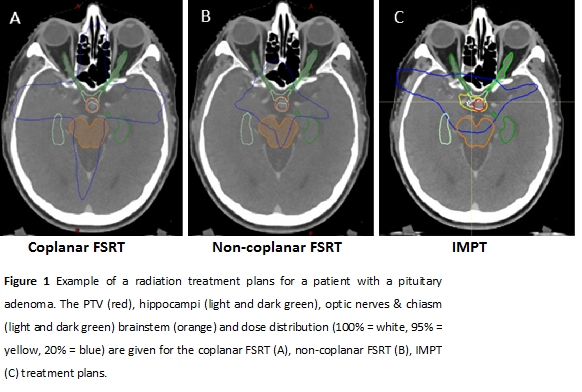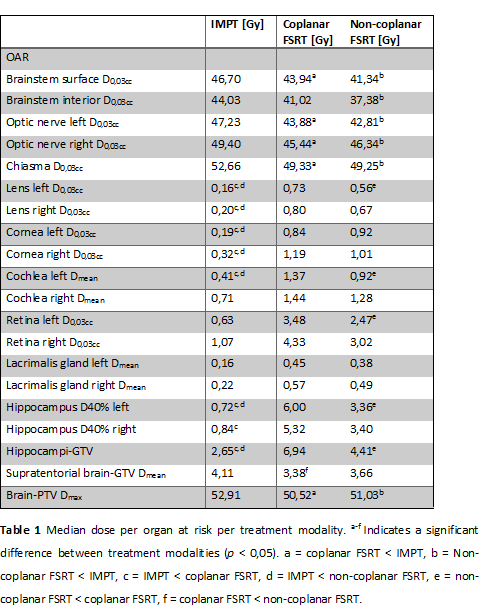Dosimetric benefits of proton therapy over (non)-coplanar photon radiotherapy in pituitary adenoma
Marloes Nogarede,
The Netherlands
PO-1959
Abstract
Dosimetric benefits of proton therapy over (non)-coplanar photon radiotherapy in pituitary adenoma
Authors: Marloes Nogarede1, Ans Swinnen1, Esther Decabooter1, Rik Emmah1, Lindsey Verheesen2, Hilde Beurskens1, Dianne Hartgerink1, Lieke in 't Ven1, Ruud Houben1, Erik Roelofs1, Daniëlle B.P. Eekers1, Inge Compter1
1Department of Radiation Oncology (Maastro), Maastricht University Medical Center+, GROW School for Developmental Biology and Oncology, Maastricht, The Netherlands, Maastricht, The Netherlands; 2Department of Radiation Oncology (Maastro), Maastricht University Medical Center+, GROW School for Developmental Biology and Oncology, Maastricht, The Netherlands;, Maastricht, The Netherlands
Show Affiliations
Hide Affiliations
Purpose or Objective
Pituitary adenomas are benign tumors arising in the adenohypophysis. Fractionated stereotactic radiotherapy (FSRT) has shown to be an effective treatment with local control rates of up to 85 - 97% at 10 years(1). However, referral for radiotherapy has been limited to patients uncured by surgery or medical therapy due to concerns for long-term toxicities such as cognitive decline. This study investigates the dosimetric benefit of intensity modulated proton therapy (IMPT) compared to (non)-coplanar FSRT for patients with a pituitary adenoma.
Material and Methods
Fifteen patients treated between 2017 and 2021 were included. The GTV and OARs were delineated according to the ESTRO/ACROP and EPTN guidelines(2,3) respectively. A PTV margin of 1 mm was added to the GTV for FSRT. IMPT treatment plans were created with four beam angles for each patient using a robust optimized plan. IMPT, coplanar and non-coplanar (gantry 0-179°, couch 270°) FSRT treatment plans to a total dose of 50.4 - 52.2 Gy in 28 – 29 fractions to the target volume were generated. The dose constraints and priorities for the OARs were defined according to the EPTN guideline(4). Treatment plans were analysed with regard to coverage and dose to surrounding OARs using the Friedman test and (when applicable) post-hoc Wilcoxon signed-rank test, all with significance level α=0.05.
Results
A total of 45 plans (IMPT, co-planar and non-coplanar FSRT) were analysed. An example is shown in Figure 1. No significant differences in coverage of the target volume were observed. When compared to (non)-coplanar FSRT the IMPT max dose (D0,03cc) in the lens and cornea was significantly lower (Table1). Also, the mean dose (Dmean) to the left cochlea and both hippocampi-GTV and dose to 40% of the hippocampi (D40%) was significantly lower for IMPT. The D0,03cc to the brainstem, optic nerves and chiasm were significantly higher for IMPT, but remained under their respective constraints for all three techniques.


Conclusion
IMPT significantly reduces the dose to the hippocampi for patients with pituitary adenomas when compared to coplanar and non-coplanar FSRT. This may result in a significant reduction of long-term toxicity such as cognitive decline.
References
1. Minniti G et al. Pituitary. 2018;21(2):154-161
2. Combs SE et al. Radiother Oncol. 2021 Mar;156:80-94.
3. Eekers DB et al. Radiother Oncol. 2018 Jul;128(1):37-43.
4. Lambrecht et al. Radiother Oncol. 2018 Jul;128(1):26-36.